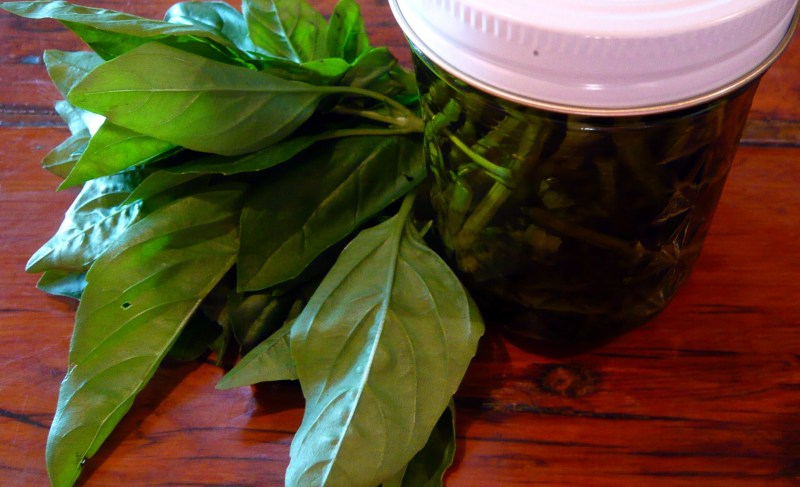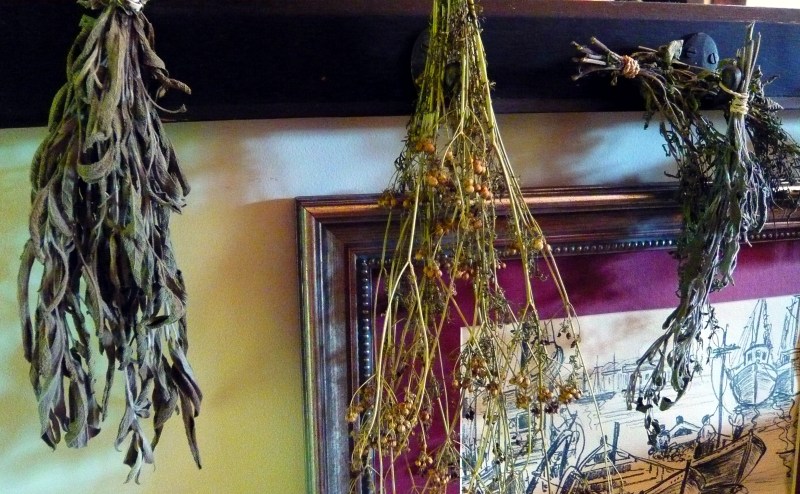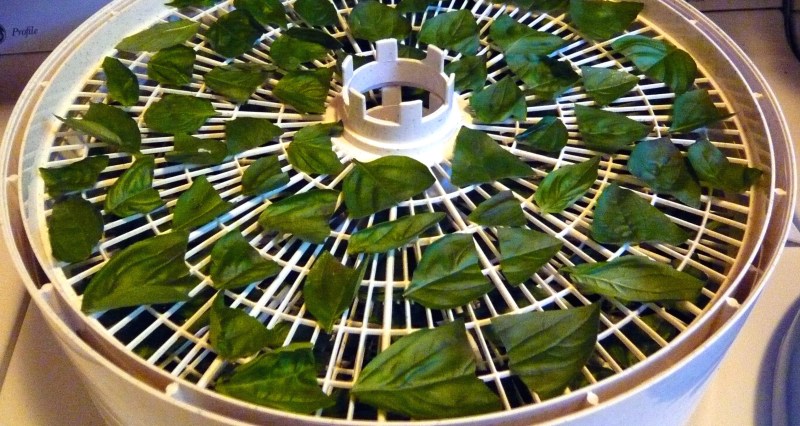
Don’t let those overflowing garden herbs go to waste – with some easy preserving ideas, you can enjoy flavorful herbs all winter long.
————————————————————-
Preserving Herbs
FREEZE
Basics: Follow the instructions for freezing vegetables, namely a quick blanche in boiling water followed by a ice-water bath. Dry thoroughly, then freeze, either on the stem, loose leaves, or chopped, spooned into ice cube trays, and covered with filtered water or olive oil. Also see a recipe for Chile Verde Base, which uses up large bunch of cilantro in a tomatillo-chile stew base.
Use: Best used in soups or stews, over pasta, on pizza or crostini or in hummus or bean spread.
PESTO
Basics: Pesto is a paste made of herbs (or sun-dried tomatoes, or arugula, or hazelnuts, etc.), olive oil, and usually garlic, salt & pepper, and possibly nuts or cheese. Pesto recipes are in general quite adaptable; here are recipes for basil-sage pesto, mint pesto, cilantro pesto, ramp & cilantro pesto and lemon-basil pesto. Pesto freezes well and will keep for up to 1 year. I sometimes freeze cubes of pesto in ice-cube trays, but also will freeze 1/2 cup portions in small plastic containers. Pesto can be thawed and refrozen a few times without harm.
Use: On pizza or pasta, in beans, stews or soups, on crostini or on a cheese or vegetable tray.
 DRY
DRY
Basics: Wash, stem, and separate leaves from larger leafed herbs (basil, sage, mint), or dry directly on the stem (thyme, dill, oregano). Lay them individually, without touching, on the trays of a dehydrator, or on baking sheets. Dry in the dehydrator at 105 degrees F for 18-24 hours, or in your oven as low as it will go (range is usually 150 – 200 degrees F) and start checking at 8 hours. Herbs are dry enough when they crumble easily between your fingers (insufficiently dried herbs can mold in the jar). You can dry smaller leafed herbs (savory, dill, oregano, thyme, coriander) by simply hanging bunches upside down, somewhere warm & dry where air can circulate. It usually takes a couple of weeks for the herbs to completely dry (or more, in all the wet weather we’ve been having!). Then strip and/or crumble the leaves off of the stems and store in Ziploc bags or glass herb jars up to 6 monhts. I generally do not dry parsley, cilantro or chives, as these herbs simply lose too much flavor on drying. I will chop and freeze these instead.
Use: Any recipe that calls for dried herbs.
HERB OIL & BUTTER
Herbed Oil: Don’t throw away those herb stems – they have a lot of flavor. Basil, cilantro, parsley, sage; remove the leaves and dry or freeze, then pack the clean stems into a jar, fill with good-quality olive oil, and refrigerate for 1 to 2 weeks. Include a couple of large, fresh leaves. The stems and leaves will infuse the oil with the herb’s flavor; after a week or two, strain the herbs out of the olive oil and store the oil in a clean jar of bottle in a cool (room temperature), dark spot. Do not keep any fresh herbs in the olive oil during long-term storage due to the risk of botulism.
Use: Over pasta, in soups or stews, for crostini or vinaigrette.
 Herbed Butter: Add 1/4 cup of chopped, fresh herbs to 1 stick (1/2 cup) softened butter, along salt & freshly ground black pepper to taste. Mix thoroughly with a fork until the herbs are well-incorporated into the butter. Form into a cylinder wrapped in wax paper or plastic wrap, or pack into a ramekin. Chill in the refrigerator until solid (about 1 hour) or freeze, well-wrapped, for up to 6 months.
Herbed Butter: Add 1/4 cup of chopped, fresh herbs to 1 stick (1/2 cup) softened butter, along salt & freshly ground black pepper to taste. Mix thoroughly with a fork until the herbs are well-incorporated into the butter. Form into a cylinder wrapped in wax paper or plastic wrap, or pack into a ramekin. Chill in the refrigerator until solid (about 1 hour) or freeze, well-wrapped, for up to 6 months.
Use: Slather on fish or steak, use to cook an omelet or scrambled eggs, make crostini or a savory pastry crust, or spread on your favorite bread.
CAN
Herbs, as low-acid foods, cannot be safely canned in a boiling-water bath. I assume that herbs could be pressure-canned, but since many are such delicate leaves, they would likely lose a lot in flavor and texture from pressure canning. Much better is drying or freezing.
Small amounts of herbs, a bay leaf or two, some basil leaves or dill, can be included with acidic foods, like tomato sauce, salsas or chutneys; herbs are featured more heavily in pickled foods, like Dilled Carrots or Garlicky Dill Pickles.
Canning herb pesto is not safe by any method, due to the low-acid, olive oil and dense texture that makes it impossible for home-canners to produce enough heat to penetrate to the middle of the pesto can, and is not recommended.
SEASON
Late Spring through Fall.

OMG I want to have that amount of herbs!!
Pingback: Lemony Mint Tea « local kitchen
how long is the herb oil good for?